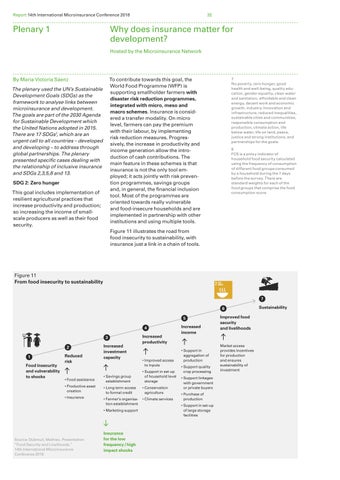Report 14th International Microinsurance Conference 2018
Plenary 1
32
Why does insurance matter for development? Hosted by the Microinsurance Network
To contribute towards this goal, the World Food Programme (WFP) is supporting smallholder farmers with disaster risk reduction programmes, integrated with micro, meso and macro schemes. Insurance is considered a transfer modality. On micro level, farmers can pay the premium with their labour, by implementing risk reduction measures. Progressively, the increase in productivity and income generation allow the introduction of cash contributions. The main feature in these schemes is that insurance is not the only tool employed; it acts jointly with risk prevention programmes, savings groups and, in general, the financial inclusion tool. Most of the programmes are oriented towards really vulnerable and food-insecure households and are implemented in partnership with other institutions and using multiple tools.
By Maria Victoria Sáenz The plenary used the UN’s Sustainable Development Goals (SDGs) as the framework to analyse links between microinsurance and development. The goals are part of the 2030 Agenda for Sustainable Development which the United Nations adopted in 2015. There are 17 SDGs7, which are an urgent call to all countries – developed and developing – to address through global partnerships. The plenary presented specific cases dealing with the relationship of inclusive insurance and SDGs 2,3,5,8 and 13. SDG 2: Zero hunger This goal includes implementation of resilient agricultural practices that increase productivity and production; so increasing the income of smallscale producers as well as their food security.
7 No poverty, zero hunger, good health and well-being, quality education, gender equality, clean water and sanitation, affordable and clean energy, decent work and economic growth, industry. Innovation and infrastructure, reduced inequalities, sustainable cities and communities, responsible consumption and production, climate action, life below water, life on land, peace, justice and strong institutions, and partnerships for the goals. 8 FCS is a proxy indicator of household food security calculated using the frequency of consumption of different food groups consumed by a household during the 7 days before the survey. There are standard weights for each of the food groups that comprise the food consumption score.
Figure 11 illustrates the road from food insecurity to sustainability, with insurance just a link in a chain of tools.
Figure 11 From food insecurity to sustainability 7 6 5 4 3 2 1 Food insecurity and vulnerability to shocks
Reduced risk
Increased investment capacity
Increased productivity
• Improved access to inputs
• Food assistance
• Savings group establishment
• Support in set-up of household level storage
• Productive asset creation
• Long term access to formal credit
• Conservation agriculture
• Insurance
• Farmer’s organisation establishment
• Climate services
• Marketing support
Source: Dubreuil, Mathieu. Presentation “Food Security and Livelihoods.” 14th International Microinsurance Conference 2018
Insurance for the low frequency / high impact shocks
Increased income
• Support in aggregation of production • Support quality crop processing • Support linkages with government or private buyers • Purchase of production • Support in set-up of large storage facilities
Improved food security and livelihoods
Market access provides incentives for production and ensures sustainability of investment
Sustainability
